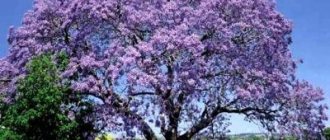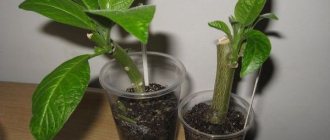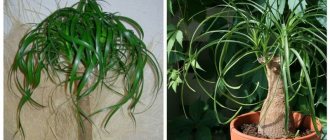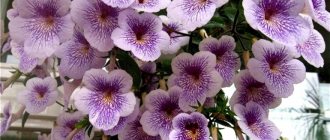In warmer regions, Brugmansia can be used as a garden crop. In most Russian regions it is cultivated as a pot or indoor plant. Brugmansia is native to the tropics and subtropics of South America. There are 7 wild species found there. All modern garden forms and hybrids were developed on their basis.
Be sure to pay attention to the beautiful Beloperone plant.
| Growth rate is average. |
| Basically, it blooms all summer, but if illuminated in the evening, it can bloom until winter. |
| Average difficulty of growing. |
| It is a perennial plant. |
Useful properties and toxicity of Brugmansia
At home, the local population uses Brugmansia as a medicinal plant. Its hallucinogenic properties are widely used for religious rituals. It should be borne in mind that all parts of the plant are highly poisonous. They contain high levels of scopolamine and atropine. The rich aroma of Brugmansia flowers can cause a severe headache.
Painless transplant
To successfully transplant Brugmansia, it must be done by transshipment, in early spring, at the moment when the root system has completely entwined the earthen ball. For soil, it is better to select universal mixtures enriched with peat and compost.
Do not forget about creating drainage; for this you need to pour a layer of expanded clay onto the bottom of the pot or hole. After planting, it is necessary to water the plant abundantly.
Brugmansia: care at home. Briefly
Brugmansia at home requires certain care:
| Temperature | Room temperature in summer, no higher than +15° in winter. |
| Air humidity | Requires a high humidity level of at least 60%. |
| Lighting | Intensive, when placed on the south side with shading. |
| Watering | The substrate must be kept moist at all times. |
| Priming | Light, fertile, always with a drainage layer. |
| Feeding and fertilizer | Requires constant use of fertilizers. |
| Brugmansia transplant | As it grows, sometimes up to 2-3 times a year. |
| Reproduction | Seeds or apical cuttings. |
| Features of cultivation | Requires constant shaping and pruning. |
Watering
Despite the fact that the plant tolerates hot weather well, it is extremely sensitive to lack of moisture and requires regular watering. In order for Brugmansia to feel good and please the owner, the soil must be constantly moist.
Otherwise, there is a risk that the plant will lose leaves and almost. Bushes growing in pots or other containers require daily watering. When the heat drops, you need to let the top layer of soil dry before watering.
Brugmansia: care at home. Details
Caring for Brugmansia at home requires some experience. The plant is very demanding regarding wintering conditions and watering regime.
Brugmansia flowering
Brugmansia flowers are shaped like long gramophones.
Depending on the species, they can be pink, white or yellow. They do not last long on the plant, but this more than covers the abundance of flowering. The flowering period lasts all summer. With additional lighting, Brugmansia can bloom in winter.
Temperature
Brugmansia at home develops best at temperatures from +23 to +25°. During the summer heat, the room must be ventilated as often as possible. If possible, it is best to take the flower pot out into the garden. Changes between day and night temperatures will only benefit the plant.
In winter, Brugmansia is kept at +10-15°. When such conditions are created, a period of rest begins. If there is no opportunity to reduce the temperature, the plant must be illuminated.
Spraying
Homemade Brugmansia requires constant spraying, sometimes several times a day. The air humidity level should not fall below 60%. The water must be warm and soft.
Lighting
The Brugmansia plant at home requires constant intense lighting. South oriented windows are best suited for her. On the north side it needs to be illuminated almost constantly. The lighting can be arranged using fluorescent lamps or special phyto lamps with a pink spectrum.
Watering Brugmansia
Brugmansia needs plenty of watering. During periods of intensive growth, it has to be watered up to 2 times a day.
The soil in the pot should never dry out. As flowering begins, leaf growth decreases, so watering can be reduced somewhat. In winter, when dormancy sets in, it is reduced to a minimum. In this case, the substrate should not be allowed to dry out completely. If the plant continues to grow actively in winter, keep the same intensity of watering.
Pot for Brugmansia
Brugmansia intensively grows its root system, so the pot for it should be wide and deep. And even despite this, it has to be carefully transshipped several times a year.
Priming
The soil for growing Brugmansia is made up of equal parts of well-rotted leaf soil, peat, humus and perlite. 2 parts of turf soil are added to them. You can also use a ready-made universal substrate for growing seedlings.
Feeding and fertilizers.
Brugmansia needs constant fertilization. During the period of intensive growth, it is fed with nitrogen-containing fertilizers. At the moment of bud laying, phosphorus-potassium. In this case, it is recommended to alternate mineral complexes with organic matter. On average, fertilizers are applied once a week. In winter, during the dormant period, feeding is stopped.
Transfer
Brugmansia is transplanted as it grows.
As soon as the roots have mastered the entire volume of the pot, the plant is immediately transferred to a larger container. On average, at least 3-4 transshipments are required per year. When replanting, proceed with caution; Brugmansia roots are quite fragile. To quickly restore the root system, it is recommended to use Kornevin.
How to prune Brugmansia?
The rapidly growing Brugmansia needs to be constantly shaped. In spring, all its shoots are shortened by about a third. It is very important to observe moderation. Too much pruning will significantly reduce the abundance of flowering. Since flower buds are already laid on the branches. During the summer, some of the shoots are periodically removed from the bushes. A large number of shoots reduces the number of flowers.
Brugmansia on the street, can it be taken out onto the balcony?
In the summer, Brugmansia can be taken out into the garden or onto the balcony. It is placed in well-lit places. She does not require additional sun protection. To reduce the number of waterings, the pot with the plant can be dug into the soil. The natural difference between day and night temperatures of Brugmansia is only beneficial. In such conditions, it lays a large number of flower buds. Before the onset of severe cold, the plant is brought into the house.
Wintering Brugmansia at home
To overwinter Brugmansia, you need a bright room with a temperature no higher than +10°. It is kept almost dry at high air humidity. If there is no glazed balcony or special room, the pot is placed on a bright, cool window.
To create high humidity, the plant is constantly sprayed. In such conditions, Brugmansia overwinters without any problems, in some cases it even continues to bloom. During a warmer winter, it may shed all its leaves or even die.
Lighting
The plant, accustomed to the warm, humid climate of forest plains and blooming along rocky rivers, requires constant intense light all year round. A distinctive feature of caring for Brugmansia at home is that it is not afraid of direct sunlight and is not prone to burns.
Brugmansia blooms profusely at home during the period July-December; with proper lighting, the flower can give a longer flowering period.
It is optimal to prepare a place on the south side of the house, and in winter it is better to constantly illuminate it in artificial light, since without sunbathing, indoor Brugmansia plants wither and lose their decorative appearance.
Growing Brugmansia from seeds
Brugmansia can be propagated by sowing seeds. It should be borne in mind that varietal characteristics will only be partially preserved. For sowing, prepare a light, moisture-intensive substrate from equal parts of peat, sand and perlite. The seeds are planted to a depth of no more than 1 cm. To create increased humidity, the container is covered with a piece of glass or film.
As soon as the first shoots appear, they are immediately removed. After the development of 3-4 true leaves, the seedlings are transplanted into separate containers. The main disadvantage of seed propagation is the long cultivation time. It takes 2-3 years from sowing to flowering.
Hellebore
Even bees stay away from this plant. 50 years ago it was used for medicinal purposes, but now it has become known that hellebore is extremely dangerous for humans. Multiple symptoms of poisoning include heart failure, convulsions, nausea and vomiting. Fortunately, safer medications have been found in our time. :))
Diseases and pests
When growing Brugmansia, flower growers face a number of problems:
- Brugmansia does not bloom. The problem occurs when there is an excess of nitrogen in the soil or when there is insufficient lighting.
- Shoots stretch out. Most likely the plant suffers from lack of light.
- The young leaves of Brugmansia turn yellow and fall off. The reason may lie in too much nitrogen fertilizer.
- Brugmansia is rotting. Excessive watering and heavy soil lead to the development of root rot.
- Brugmansia leaves fall in winter. The flower does not have enough light.
- Leaves are falling. The plant was very dry.
The most common pests on Brugmansia are spider mites and whiteflies.
Temperature
How to grow Brugmansia? The answer is very simple - provide proper care and create a comfortable microclimate for the flower. Brugmansia develops well at +23 to + 27°C, but easily tolerates temperatures of 30-35°C. It is important not only to maintain heat, but also to ensure good air circulation, avoiding drafts.
The July heat is the favorite time of the Brugmansia flower, planting and caring for which will be carried out during this warm period.
If in the summer you can safely take a plant into the garden, then the winter cold will destroy it. In winter, it is necessary to keep the flower in the temperature range of +12-+15°C - this allows it to go into a dormant state and wait for comfortable conditions to bloom with renewed vigor. At temperatures below 8°C, the flower dies.
Types of Brugmansia with photos and names
The following types are used in indoor floriculture:
Brugmansia sanguinea
A distinctive feature of the species are orange-red flowers with yellow veins, which have absolutely no aroma. At prolonged temperatures above +25°, the plant refuses to bloom. Under natural conditions, the species is distributed in Chile and Ecuador.
Brugmansia snow-white Brugmansia candida
The flowers are tubular in shape and have a strong scent in the evening. Their color, depending on the variety, can be white, pink or yellow. The leaves are oval-shaped, slightly pubescent, on long petioles. The species lays buds only after differences between day and night temperatures.
Brugmansia suaveolens
The species is native to eastern Brazil. In nature it grows as trees up to 5 meters high. Flowers are white or pink, up to 30 cm long.
Golden Brugmansia (Brugmansia aurea)
Tall, large plants with yellow flowers. The flowers have a characteristic outward bend. The species is native to northern Colombia.
Landing
Seeds and seedlings of attractive Brugmansia species are available for sale. After purchasing a seedling about 30 cm high, it is transplanted into a large pot.
What kind of pot is needed for Brugmansia:
- a seedling about 30 cm high is transplanted into a 10-liter pot;
- large seedling – volume 40 liters.
Suitable soil for planting Brugmansia is humus soil with a pH of 6-7.5.
Brugmansia, grown in open ground, prefers soils:
- fertile;
- well drained (with the addition of sand);
- preferably slightly acidic or neutral.
When placing Brugmansia on the balcony, it is worth remembering that on a small balcony, majestic plants may have too little space for free development.
Bloodroot
And the last one for today is cinquefoil. Its toxicity is similar to that of opium, so it is quite predictable what to expect from it. Poisoning by this plant causes drowsiness and subsequent death.
As you can see, there is a lot we don’t know about this planet and its inhabitants. It is immediately clear that it is better not to eat unfamiliar plants, and familiar ones too.
Be careful! )
Lily of the valley
Unexpected, right? But apparently there is a lot we don’t know about our earthly neighbors.) When ingested by the human body, the toxins contained in lily of the valley cause mouth pain, cramps, diarrhea and nausea.
It’s better to just admire this plant from the side, because it blooms beautifully!
Omezhnik saffron
Coniine, this is the substance this plant can boast of. By the way, it grows almost all over the country, even in your garden! When it enters the body, excitation and respiratory arrest occur. Not the best outcome, right?











